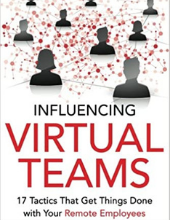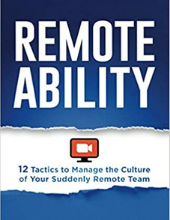Table of content
In the pre-pandemic times, outsourcing vendors acted as a middleman between a worker and a client. They also kept an eye on the supplemented specialists, thus making sure employees fulfill their responsibilities in office settings guided by PMs and HRs. And while the pandemic contributes to a long-term boost in remote working, IT outsourcing companies carry on as usual, but with revamped approaches.
It’d be great to have a playbook on how to manage a remote team during these dire times, right? Well, you can use this article as an ultimate guide on leading the newly-minted remote staff and benefit from our experience of making the leap to the remote.
Let’s get right into it.
6 Issues With Managing Employees in COVID-19 Realities
The unexpected change in work culture has naturally introduced new challenges for companies, including software development agencies. Thus, instead of focusing on core functions, business leaders make their best to guarantee adequate crisis response and keep the developers engaged.
Employees, on the other side, have a hard time adjusting to new realities and keeping balance amid the uncertainty. All these things couldn’t go unnoticed.
Let’s now discuss the top issues that companies are facing due to the COVID-19 outbreak and remote setting.
1. Lack of personal communication due to non-verbal cues
Covid-19 has generated an influx of communication mediums, such as telephone calls, email, and communication platforms. Team members don’t have the opportunity to go and ask anymore. Instead, developers and other remote workers now have to use intermediate comm channels, which drags out problem-solving.
2. Virtual team communication is not for everyone
Some people are just not into written communication since they find it difficult to voice their ideas via messages. The inability to express thoughts in a written, structured form leads to various misunderstandings and conflicts that could’ve been avoided in traditional face-to-face discussions.
3. Overage of communication channels
Flooding the channels is another problem relevant to remote team management. Development teams are both lucky and doomed to have a variety of messengers, emails, and specialized platforms. Anyway, most of the time, remote employees end up pacing back and forth between the comm channels and rummaging through a zillion messages.
4. Slowdown in productivity
Although remote development seems like a boon with unlimited working time, it has resulted in a productivity slump. Unsuitable spaces and distractions increased the task-solving timeline, which had a particular toll on workers causing frustration, stress, and aggressive behavior.
5. Lack of a physical workspace
Let’s face it: a homely atmosphere does not stimulate focus and productivity. Especially, if it means family members constantly knocking on the door or a lumpy coach serving as your power spot.
6. Loss of team spirit
Maintaining employee engagement is also a pressing issue in pandemic times. As team members lack interaction, it is harder to keep your staff connected and focused on the common goal.
Covid-19 Crisis Management Essentials At Devox Software
Leading through pandemic’s rising waters was a new thing for us as well. However, we steered our developers through the uncertain times with peace of mind. So here’s our take on managing remote employees – best practices that can be of help for your organization as well.
A program that is see-through
Transparency and accountability are tantamount to managing remote employees. That is why we’ve set up clear project goals, established structured plans and deadlines adjusted to unusual working conditions.
Although we’ve clearly seen a productivity drop, it helped our telecommuters stay on top. Also, we’ve written down other ground rules for our workers such as emergency contacts, and assigned team members responsible for organizational matters and workflows.
Feasible support of the HR department
During the lockdown, our HR specialists have been keeping every remote developer under the radar. Thus, they have regular one-to-ones to discuss any issues and keep tabs on employee wellbeing.
Also, our HRs employ virtual team building activities to enhance the scale of cooperation and boost the team spirit.
Rules of engagement
We managed to avoid a setback in communication by setting up regular standups and allocating separate tools to manage business tasks. Our company has also provided structured ways for employees to interact socially and notify others about work processes.
If your vendor is based in a different location, you might also come across the following challenges:
- Cross-cultural issues (different mentality, cultural barrier, regional peculiarities, etc)
- Time zone issues
- Language barrier (limited English proficiency, for example)
Although these challenges are inevitable in some cases, you can possibly take every precaution to avoid them or adjust as you go. However, it’s always better to do your homework beforehand. Thus, to sidestep mentality discrepancies, pick the outsourcing location that shares the same or similar values and business practices.
You don’t have to opt for nearshore outsourcing, offshore will do the justice for your business processes as well. Especially if you are looking for a particular set of values like a western mindset, for example.
If you don’t want different time zones to hinder the maximum performance of joint work, it’d be logical to create a remote team consisting of members who live in one time zone or with minimum deviations like 2-3 hours.
This way, remote developers would be able to tackle development issues together, avoid delays or downtime and have regular face-to-face check-ups. The time difference can even become your forte since business processes are up and running 24/7.
As for the language etiquettes, you can cover this area of concern by monitoring English proficiency by country. Make sure to have a one-to-one with the vendor to check his communication skills. If possible, have an English sesh with a potential remote team as well.
Now let us hop on to the battle-proven tips and tricks for successfully managing a remote workforce so that you’ll be fully prepared for the remote era.
10 Effective Tips For Managing Remote Development Team
You may think that a remote team would raise hell for your company. In reality, most of the usual principles hold true for managing a remote workforce as well, yet come with a few amendments.
Throughout our extensive experience in outsourcing, we have perfected our leading practices and now implement balanced and well-established processes for managing remote staff.
If you still lack the management acumen amidst the COVID-19 outbreak, our curated tips will point you in the right direction and share all secrets of how to manage remote employees.
1. Use regular reporting
High-performing virtual teams always remain accountable for accomplished tasks. However, with no actual daily interaction, managers have less line-of-sight to how remote developers do their work than usual.
That is why crystal-clear process documentation and checklist workflows are among the go-to tips for managing remote workers. While reporting may come in various shapes and forms, our remote teams have narrowed it down to the following docs:
- Written report
- Standup or call-up
- Demo for presenting the product functionality (this one comes especially useful if our clients have to report back to investors)
Reporting methods can be combined as needed. Reporting frequency mainly depends on the size of your remote workforce.
Big remote dedicated teams should practice rigorous tracking on a day-to-day basis. Daily reports allow us to understand where the process stands for each remote developer and clear up the backlog that accumulates during the day. If pressing issues remain unsolved, they will slack off the development process.
Small and middle-sized teams should report on progress made once a week if it feels like team members are all on the same page.
2. Establish upfront goals
Defining clear objectives with specific metrics, following established timelines for check-ins and evaluation periods are among other essentials of how to manage a remote team.
Setting up expectations, goals, and cultural norms are not new for companies, but managers must walk this extra mile each time in the remote setting since it’s particularly challenging to monitor the performance outside the office.
Therefore, team-face work-from-home planning helps managers of remote workforce envision success and achieve it.
3. Set up ad-hoc calls
While chatting appears counterproductive for remote developers, audio-only calls help actually get the communication to work. As a rule, it’s easier and quicker to bring information via calls provided team members do the upfront planning. Callers should chart out the structure of their discussion beforehand and make sure they won’t miss any important details.
After the one-to-one, team members can write down a short summary to be on the safe side. Another useful trick is to record a call in order to go over the important moments once you forget something.
Some remote teams practice daily calls to keep abreast, but it might not always be the case. If you don’t have the constant flow of new information, keep it lower to stay focused.
4. Ensure regular check-ins
Consistent communication is key to both managing a remote workforce and building rapport with a client. From the team management standpoint, regular meetings, check-in, and calls serve as a reminder for the end goals.
Open and transparent communication also encourages your remote employees to share their challenges, progress, and accomplished results. Also, by checking in at regular intervals, you can touch base on any current or potential roadblocks before they pose a threat.
As for the client’s side of things, keep your communication stable, effective and valuable.
5. Choose the main communication channel
A common mistake that telecommuters make is using multiple communication channels. Instead of distributing info across a combination of collaboration tools, keep the internal communication ecosystem as simple as possible.
Therefore, you need to choose a central communication platform with all the important information reachable at all times. The perfect comm channel should be functional (but not over functional), intuitive and client-friendly.
6. Facilitate warm-up activities for one-to-ones
Successful managers and leaders always tap into the energy, motivation, and creativity of their people. One way to do that is to start the call with warm-ups and icebreakers.
When done wisely, these activities lay the ground for a productive, positive meeting and set up a group’s energy from the start. Even the simple: “How are you doing? How’s your week going?” and so on can build camaraderie and boost performance and productive capacity.
7. Pick the right PM and time tracking tool
The importance of project management tools is apparent for any project manager worth his salt. A PM tool allows to easily establish a hierarchy of tasks, define sequential steps, track budget, and optimize resources. In turn, this makes it easier for the team to carry on with their responsibilities.
Time tracking, on the other hand, allows project managers to keep a watch on the working hours spent on individual tasks and on the project as a whole. Just like with the communication platforms, it is recommended to have your choice of any familiar and functional software.
8. Run a retrospective
The retrospective meeting is a famous Agile technique that helps reflect on the accomplished progress and discuss success or failure. Usually, the meeting is held by the team members and the client. The parties discuss:
- What went well in the process
- What could be improved
- What actionable and committed improvements can be done in the next cycle (action items)
Retrospectives are built on the premise that an empowered team can identify the hidden pain points by clearly articulating the current state of things. Also, it is a great opportunity to fetch feedback for your remote team which will assist in understanding the project requirements better.
9. Don’t make it all about work
For teams to collaborate effectively, they need to improve interpersonal relationships between employees. Shared experiences bring team members closer and make them trust each other.
For that purpose set up chats and call ups so that employees can shoot the breeze and build some informal interaction. Also, team building activities are the most important investment to encourage communication and establish a healthy company culture.
10. Avoid over-controlling
Overcontrolling can breed failure in your workers. Despite regular reporting, your remote workforce shouldn’t feel vigilant all the time being supervised by Big Brother. Do not look over the shoulders of your staff and allow the freedom of opinion.
Managing a remote workforce requires a different approach that finds a happy medium between supervision and trust. Although learning how to manage a remote team without micromanaging can be challenging, a few tweaks can supercharge your remote developers for peak efficiency
Now, those were our tried and true tips and tricks on how to manage a remote team. Obviously, this is not an exhaustive list of all work-from-home subtleties, since there’s no chance we could squeeze it all in one post.
However, we have something interesting up our sleeve that will help whip your management skills in shape as well.
10 Best Books for Remote Team Management
Whether you are an in-office manager or a newly-minted telecommuter, while you work remotely, you need to explore by reading wide. So here are our top ten best books on how to manage staff in a remote setting.
1. Remote, Office Not Required – Jason Fried & David H. Hansson
Remote, Office not required is the absolute gem favored by managers working remotely. The book unravels the notion of remote work from start to finish and lays out the core principles of telecommuting. If you’re a manager concerned about managing employees, this book is your indispensable guide.
2. The Long-Distance Leader: Rules for Remarkable Remote Leadership – Kevin Eikenberry and Wayne Turmel
This one is another compulsively readable case for a radically remote workplace based on research with real-life practicing managers. The book provides insights for leaders on how to guide their workforce by recalling the foundational principles of leadership. Packed with practical exercises that ensure projects hold the line, keep performance and spirits high, this book is the go-to guide for managing remote staff.
3. Office Optional: How to Build a Connected Culture with Virtual Teams – Larry English
Sprinkled with insightful stories, this book unpacks everything linked with sustaining a culture of collaborative teams at a distance. In particular, the guidebook shares how to cultivate an atmosphere of trust, build strong rapport and scale your virtual company in a remote environment.
4. Influencing Virtual Teams: 17 Tactics That Get Things Done with Your Remote Employees – Hassan Osman
Written by Hassan Osman, this book is a must-read for established managers and newbies. The author talks about consistent tactics that encourage remote teams to obtain some level of commitment in achieving their tasks. You’ll learn a secret formula for establishing trust with your team, ensure 100% commitment, and even how to record a perfect voice message.
5. Distributed Teams: The Art and Practice of Working Together While Physically Apart – John O’Duinn
This easy-flipping book has succinct chapters with practical takeaways on topics like how to run effective video calls and meetings. Backed by 26+ years working in distributed teams, the author gathers do’s and don’ts of remote management along with tips from company founders, software engineers, data scientists, and others.
6. Working Remotely: Secrets to Success for Employees on Distributed Teams – Teresa Douglas
This book will be particularly helpful for managers who want to tap into the minds of their remote workers or help employees adjust their day-to-day activities to the new setting. It also focuses on how to manage virtual personnel and points out the fortes that employees have to drive success for themselves.
7. Remoteability: 12 Tactics to Manage the Culture of Your Suddenly Remote Team – Russ Hill, Jared Jones, Tanner Corbridge
Authored by culture management experts, this fresh tiny guide shares best practices from Fortune 500 companies. The book was created with the new Covid-19 realities in mind and tells us how various industries have been navigating through the pandemic. In Remoteability you’ll pick up 12 actionable tactics for managing your remote power.
8. Virtual Culture: The Way We Work Doesn’t Work Anymore – Bryan Miles
In this book, Bryan Miles prepares managers for the workplace apocalypse by sharing insights on how to create a virtual workforce with a killer culture. Being a co-founder of one of 500 Inc companies, Mr.Miles has mastered the virtual culture himself and is ready to uncover the secrets of the ultimate remote principles.
9. The Year Without Pants: WordPress.com and the Future of Work – Scott Berkun
Here you’ll get a unique backstage story the author tells about creativity, productivity, and leadership from a company called Automattic, Inc. The book reveals vital lessons about work culture and managing creativity that were obtained at one of the most successful companies known as WordPress.
10. Virtual Possibility: How to Set up, Lead, and Manage Your Own Successful All-Remote Company – Shelly Spiegel
Leaning on nearly two decades of experience, the author provides step-by-step guidance on running a fully remote team. The book is filled with practical information and tips on hiring and onboarding top talent, creating an effective organizational structure as well as managing and motivating your remote staff.
If it’s not enough for nailing the work-from-home philosophy, we have other goodies in store.
Free Сourses On Managing Remote Employees
To knock out the fixed desk working, we’ve curated a shortlist of courses that will also become a valuable addition to your management arsenal.
1. Remote Leadership Training: How to Manage a Remote Team – HubSpot
This short course is geared towards managers who want to foster an effective and productive climate for their remote teams. The course consists of a 4-video lesson that pinpoints the main work-from-home challenges, offers a list of remote tools, and shares practical tips on how to create a virtual office.
2. How to Manage a Remote Team – GitLab
This course is a must for operating managers and HR professionals who want to pick up the skills of leading a viable, scalable remote workforce. By the end of it, you’ll have the know-how to navigate a remote environment, establish a robust remote organizational culture and practices and have a ready-to-go strategy for driving a remote transformation.
3. Managing Remote Teams with Upwork – Upwork
This free 1-hour course is a great time investment for managers who are interested in building and managing remote teams. You’ll soak up hands-on experience from leading industry practitioners and know how to implement remote-work best practices into your existing workforce.
4. Managing Remote Teams – Doru Catana
This is a 90-minute crash course that covers everything you need to become an excellent manager of a remote team. The course program features fundamental things like work-from-home principles and systems as well as the right tools to make your managing life easier. You will also hone up your communication skills and find out more about systems specific to remote work that are seamless, efficient, and strike the optimum balance between work and social interaction.
5. Collaborative Working in a Remote Team – University of Leeds
Featured in the UK government’s The Skills Toolkit collection, this 2-week course is an all-important guide for managers seeking a step-by-step action plan. You’ll cover a wide range of topics starting from the challenges and opportunities of remote working to tools and resources fine-tuned to the virtual setting.
Bonus:
6. Human-Centered Design for Work at a Distance – The University of British Columbia (Paid Course)
This self-paced expert course introduced by the University of British Columbia focuses on human-centered design for remote working. It helps managers gain an in-depth understanding of human-centered design tools and frameworks and visual models to help stimulate and prototype palpable trailblazing ideas. Each module features inspiring video conversations with guest speakers that share their transformational experience so you can glean best practices from these case studies.
The Final Word
The outbreak of the novel coronavirus has crippled the usual world system. It prompted business leaders all over the world to turn their usual business processes out of whack and commit to the virtual setting. However, since work-from-home has always been embedded in our DNA, our company can share practical tips and strategies of how to manage a remote team. We hope that our valuable insights will help you fast-track the remote working trend and make the most of it.

![How To Manage A Remote Team? [COVID-19 Edition]](https://devoxsoftware.com/wp-content/uploads/2020/06/kanhaiya-sharma-_HdRQWJ-Pt8-unsplash.jpg)



















